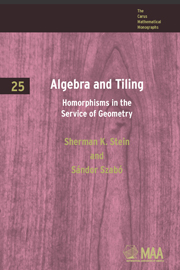Book contents
- Frontmatter
- Preface
- Contents
- Chapter 1 Minkowski's Conjecture
- Chapter 2 Cubical Clusters
- Chapter 3 Tiling by the Semicross and Cross
- Chapter 4 Packing and Covering by the Semicross and Cross
- Chapter 5 Tiling by Triangles of Equal Areas
- Chapter 6 Tiling by Similar Triangles
- Chapter 7 Rédei's Theorem
- Epilog
- Appendix A Lattices
- Appendix B The Character Group and Exact Sequences
- Appendix C Formal Sums
- Appendix D Cyclotomic Polynomials
- Bibliography for Preface
- Supplement to the Bibliography
- Name Index
- Subject Index
- Symbol Index
Chapter 5 - Tiling by Triangles of Equal Areas
- Frontmatter
- Preface
- Contents
- Chapter 1 Minkowski's Conjecture
- Chapter 2 Cubical Clusters
- Chapter 3 Tiling by the Semicross and Cross
- Chapter 4 Packing and Covering by the Semicross and Cross
- Chapter 5 Tiling by Triangles of Equal Areas
- Chapter 6 Tiling by Similar Triangles
- Chapter 7 Rédei's Theorem
- Epilog
- Appendix A Lattices
- Appendix B The Character Group and Exact Sequences
- Appendix C Formal Sums
- Appendix D Cyclotomic Polynomials
- Bibliography for Preface
- Supplement to the Bibliography
- Name Index
- Subject Index
- Symbol Index
Summary
In the first four chapters we examined tilings of Euclidean space by translates of sets that are unions of cubes. In this chapter we consider tilings of a much different character, namely tilings of polygons by triangles of equal areas. (We do not demand that the triangles be congruent.) We restrict our attention to simplicial dissections, though the theorems hold for all dissections.
In 1965 Fred Richman at the University of New Mexico at Las Cruces wanted to include a geometric question in a master's degree examination he was preparing. “I noticed that it was easy to cut a square into an even number of triangles of equal areas, but I could not see how to cut it into an odd number.” Not solving his problem, he chose not to put it on the examination. However, he did show that the square could not be cut into three or five triangles of equal areas and mentioned the problem to his colleague and bridge partner, John Thomas. Thomas recalls that
Everyone to whom the problem was put (myself included) said something like ‘that is not my area but the question surely must have been considered and the answer is probably well known.’ Some thought they had seen it, but could not remember where. I was interested because it reminded me of Sperner's Lemma in topology, which has a clever odd-even proof.
- Type
- Chapter
- Information
- Algebra and TilingHomomorphisms in the Service of Geometry, pp. 107 - 134Publisher: Mathematical Association of AmericaPrint publication year: 2009



